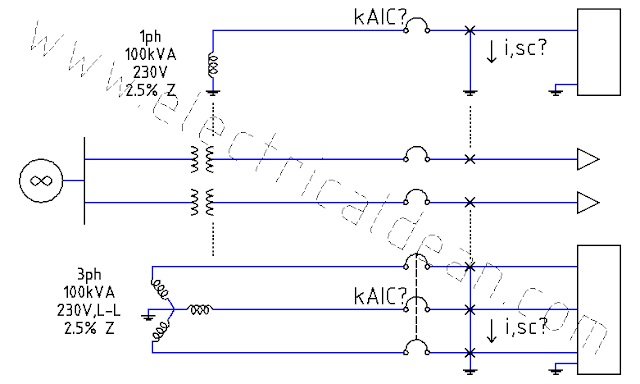Circuits - Scenario 3
SITUATION
A defective battery is found to have excessive heat losses during quality control tests. How its internal resistance determined to verify if it matches with its original design specification?
ANALYSIS
1.) One-line diagram:
o|---EMF,batt---R,batt---R,load---|>
EMF,batt = battery internal electromotive force
R,batt = battery internal resistance
R,load = dummy load resistance
2.) Ohm's Law:
V,load = i * R,load
i = V,load / R,load
3.) KVL:
(-EMF,batt) + i * (R,batt + R,load) = 0
(-EMF,batt) + (V,load / R,load) * (R,batt + R,load) = 0
(-EMF,batt) + (V,load / R,load) * R,batt + V,load = 0
V,load (R,batt / R,load) = EMF,batt - V,load
R,batt / R,load = (EMF,batt / V,load) - 1
R,batt = [ (EMF,batt / V,load) - 1 ] * R,load
At no load: V,NL = EMF,batt
At full load: V,FL = V,load
R,batt = [ (V,NL / V,FL) - 1 ] * R,load
CONCLUSION
The internal resistance of a battery can be determined by measuring its no-load voltage, then placing a known resistance across its terminals to measure its loaded voltage, and plugging all of these data into the derived equation above.
Note:
The difference between the no-load and the loaded voltages might be small, usually around 1/1000, so a digital multimeter with precision of at least three decimal places (0.001) may be needed.
A defective battery is found to have excessive heat losses during quality control tests. How its internal resistance determined to verify if it matches with its original design specification?
ANALYSIS
1.) One-line diagram:
o|---EMF,batt---R,batt---R,load---|>
EMF,batt = battery internal electromotive force
R,batt = battery internal resistance
R,load = dummy load resistance
2.) Ohm's Law:
V,load = i * R,load
i = V,load / R,load
3.) KVL:
(-EMF,batt) + i * (R,batt + R,load) = 0
(-EMF,batt) + (V,load / R,load) * (R,batt + R,load) = 0
(-EMF,batt) + (V,load / R,load) * R,batt + V,load = 0
V,load (R,batt / R,load) = EMF,batt - V,load
R,batt / R,load = (EMF,batt / V,load) - 1
R,batt = [ (EMF,batt / V,load) - 1 ] * R,load
At no load: V,NL = EMF,batt
At full load: V,FL = V,load
R,batt = [ (V,NL / V,FL) - 1 ] * R,load
CONCLUSION
The internal resistance of a battery can be determined by measuring its no-load voltage, then placing a known resistance across its terminals to measure its loaded voltage, and plugging all of these data into the derived equation above.
Note:
The difference between the no-load and the loaded voltages might be small, usually around 1/1000, so a digital multimeter with precision of at least three decimal places (0.001) may be needed.





Comments
Post a Comment